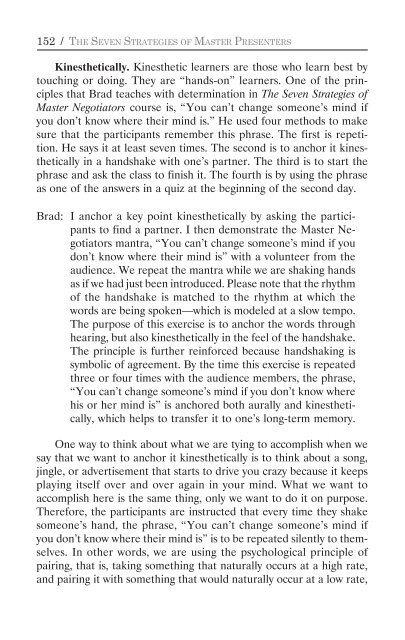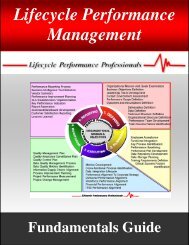The Seven Strategies of Master Presenters - Lifecycle Performance ...
The Seven Strategies of Master Presenters - Lifecycle Performance ...
The Seven Strategies of Master Presenters - Lifecycle Performance ...
You also want an ePaper? Increase the reach of your titles
YUMPU automatically turns print PDFs into web optimized ePapers that Google loves.
152 / THE SEVEN STRATEGIES OF MASTER PRESENTERS<br />
Kinesthetically. Kinesthetic learners are those who learn best by<br />
touching or doing. <strong>The</strong>y are “hands-on” learners. One <strong>of</strong> the principles<br />
that Brad teaches with determination in <strong>The</strong> <strong>Seven</strong> <strong>Strategies</strong> <strong>of</strong><br />
<strong>Master</strong> Negotiators course is, “You can’t change someone’s mind if<br />
you don’t know where their mind is.” He used four methods to make<br />
sure that the participants remember this phrase. <strong>The</strong> first is repetition.<br />
He says it at least seven times. <strong>The</strong> second is to anchor it kinesthetically<br />
in a handshake with one’s partner. <strong>The</strong> third is to start the<br />
phrase and ask the class to finish it. <strong>The</strong> fourth is by using the phrase<br />
as one <strong>of</strong> the answers in a quiz at the beginning <strong>of</strong> the second day.<br />
Brad: I anchor a key point kinesthetically by asking the participants<br />
to find a partner. I then demonstrate the <strong>Master</strong> Negotiators<br />
mantra, “You can’t change someone’s mind if you<br />
don’t know where their mind is” with a volunteer from the<br />
audience. We repeat the mantra while we are shaking hands<br />
as if we had just been introduced. Please note that the rhythm<br />
<strong>of</strong> the handshake is matched to the rhythm at which the<br />
words are being spoken—which is modeled at a slow tempo.<br />
<strong>The</strong> purpose <strong>of</strong> this exercise is to anchor the words through<br />
hearing, but also kinesthetically in the feel <strong>of</strong> the handshake.<br />
<strong>The</strong> principle is further reinforced because handshaking is<br />
symbolic <strong>of</strong> agreement. By the time this exercise is repeated<br />
three or four times with the audience members, the phrase,<br />
“You can’t change someone’s mind if you don’t know where<br />
his or her mind is” is anchored both aurally and kinesthetically,<br />
which helps to transfer it to one’s long-term memory.<br />
One way to think about what we are tying to accomplish when we<br />
say that we want to anchor it kinesthetically is to think about a song,<br />
jingle, or advertisement that starts to drive you crazy because it keeps<br />
playing itself over and over again in your mind. What we want to<br />
accomplish here is the same thing, only we want to do it on purpose.<br />
<strong>The</strong>refore, the participants are instructed that every time they shake<br />
someone’s hand, the phrase, “You can’t change someone’s mind if<br />
you don’t know where their mind is” is to be repeated silently to themselves.<br />
In other words, we are using the psychological principle <strong>of</strong><br />
pairing, that is, taking something that naturally occurs at a high rate,<br />
and pairing it with something that would naturally occur at a low rate,










